 Farewell to Billie
Farewell to Billie
Long-time and regular readers of this blog may remember our cat Billie, who made occasional appearances in my posts, serving as a mascot of sorts for it. She joined our household on May 9, 2012, exactly ten years to the day before her unexpected departure therefrom.
We inherited Billie — a Bengal cat, the only feline of a specific breed with whom I’ve ever shared my home — from a well-to-do French couple who commuted between New York, Paris, and Normandy, taking her with them via plane, train, and car. Hard to imagine any cat who would feel comfortable with such a peripatetic lifestyle. By the time we met her, at the age of two, the disconnect between their choices and her needs had become obvious, and they wanted to rehome her. We agreed happily when they offered her to us.
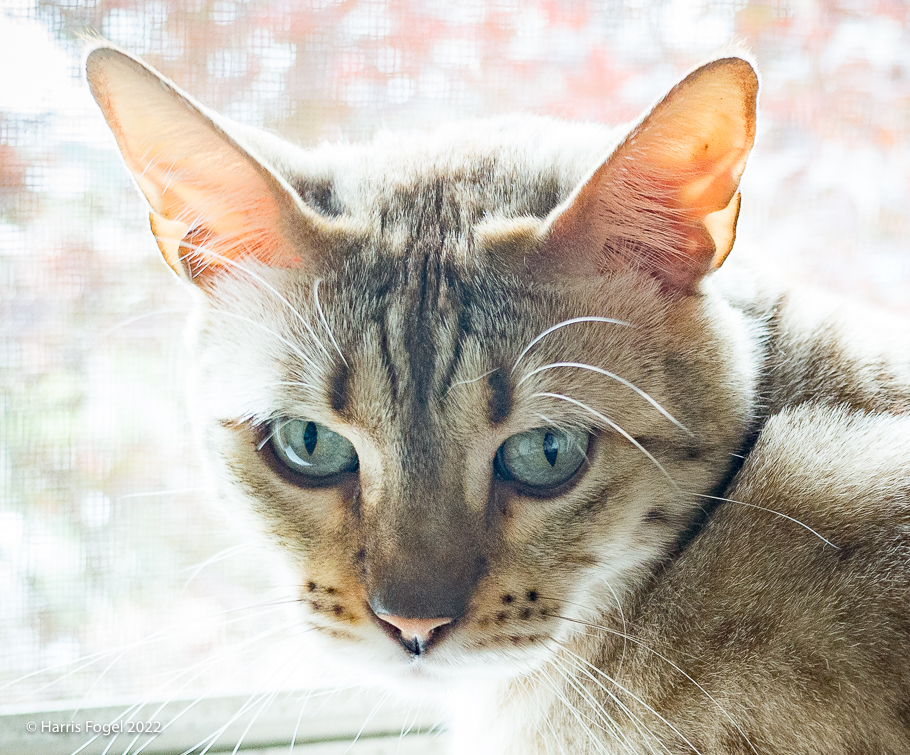
Billie in 2012. Photo by Harris Fogel.
Billie proved herself a creature of habit. She quickly found favorite spots in the house for napping and sleeping and sunning and grooming herself. She was not especially playful — toys held little interest for her — or affectionate. She wanted to be around us yet kept to herself. Not a cuddler, in short. She rarely even rubbed up against us, but vocalized greetings and requests, convincing Anna that she recognized several dozen words. I remained skeptical, but Billie and I had shorter conversations. Yet I sensed a distinct, keen intelligence in her that set her apart from the other cats I’ve known.
Unlike all my previous cats, she showed no interest whatsoever in any human food — not even bacon. (Inexplicably, however, she loved rolling around on plastic bags containing bunches of fresh carrots and celery, though she didn’t want to eat those veggies. Something about the smells intoxicated her.) Instead, she preferred one particular brand of wet food (9Lives), and only a few specific flavors thereof.
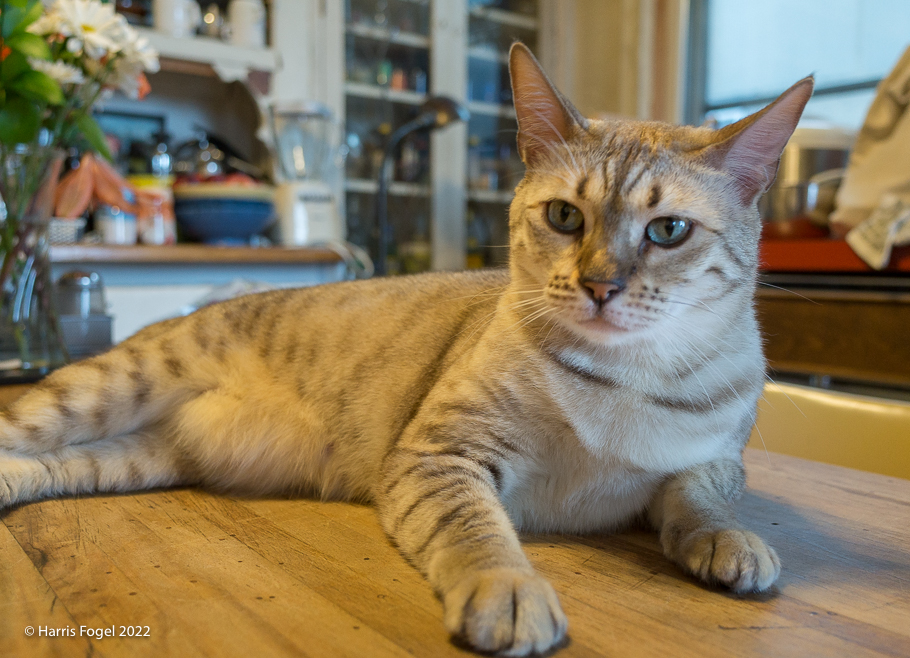
Billie on the kitchen table. Photo by Harris Fogel.
She had a hearty appetite, so we ended up concocting a mixture of half a can thereof with a bit of the only dry food she liked (Purina Indoor Cat Chow) plus a tablespoon or two of hot water. She ate that happily, twice a day, from the time shortly after her arrival until just before the end.
Bengals are a relatively recent breed, crosses between domestic felines and small forest cats, so she wasn’t many generations away from her wildness on that side. Heavy when full-grown (13.5 lbs. in her later years) and muscular, Billie had strong fighting instincts, evidenced whenever one played with her — she’d nip hard and use her back claws. We suspected her breeder had separated her from her mother and litter-mates too early, because she had never fully internalized bite inhibition.
A few months after getting Billie we adopted a small, fine-boned, feral mixed-breed kitten whom we named Mini as a buddy for her, and they played and slept together for a year or so until one day in our garden they had an inexplicable, terrible fight that permanently ended their companionship from Billie’s standpoint. A single-event learner. Thereafter Billie lived downstairs and Mini upstairs, never crossing paths again.
I suppose you could classify her as neurotic, perhaps the genetic result of her breeding. But also possibly the result of premature weaning, getting declawed by either the breeder or her previous owners (a cruel practice that involves amputating the last digits of their toes), plus the disorienting home life she experienced before she came to us. She could turn irritable and nip at you painfully, sometimes drawing blood, even as you petted her gently. When deeply irked she made a sharp, plosive sound that I transliterated as “KAH!!” — something I’ve never heard from another cat.
Her relationships with us proved very specific. She loved Anna most of all, talked to her, went to her for comfort, stood on her lap for minutes of petting, slept next to her when we allowed her into the bedroom at night. She treated our son Jacky, with whom she lived upstairs for her first few months here, as her alpha male; he could wrestle with her and manhandle her (always gently) and she enjoyed that without fighting back.
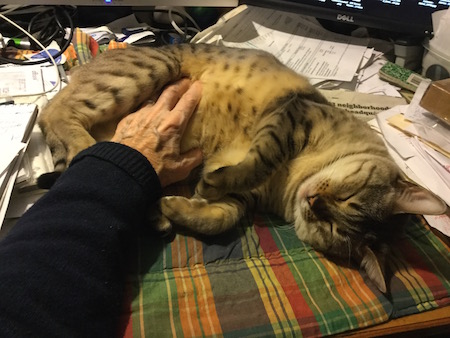
Billie asleep on Allan’s desk, December 2017. Photo © A. D. Coleman.
Me she tolerated. For the first five years she would nap on my desk; that stopped, and I could never figure out why, since she was always welcome there. Instead, right up to the end she would visit me in the office several times a day to demand my attention and a brief stroking. I could count the times she jumped up on my lap over the past decade on the fingers of one hand, and the times she slept next to me at night on my fingers and toes.
However, if I was away for a stretch, Anna reported that Billie would nap on my office chair in the daytimes. And dependably in the mornings, after I fed her breakfast, she would climb up onto the kitchen table and lie down, her way of asking for (commanding) a deep massage; that could go on for five minutes or so before she’d jump down or suddenly KAH! me to signal that she’d had enough. No question that she considered herself the queen of the household; she had an imperious manner.
Which was fine. We considered her perfect as she was, and felt happy that we could offer her a permanent, stable home where she felt safe, comfortable, loved, and cared for. On warm sunny days either Anna or I would take her on a leash into the back garden, where she would patrol the perimeter and then, depending on her mood, sit or lie down in a shady spot for a stretch. In the winter she’d settle for some homegrown catnip and a snooze on the tile floor of our sunporch.
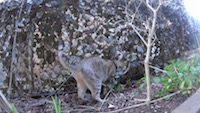
Billie on the prowl, 4-11-15. Photo © A. D. Coleman.
Those routines rolled on, season after season, year after year. Then, early this past April, she started to throw up. At first we assumed hairballs caused it — shedding time for her winter coat — and didn’t worry too much. But it persisted, became daily, and she went off her feed. We tried puréeing her food, but she couldn’t keep it down. The vet recommended a regimen of pepcid, which she absolutely hated (stubborn as a mule, she always got angry when forced to do anything). In any case, it didn’t work. She lost her usual appetite, eating less than half her normal serving, and dropped two pounds in six weeks.
An ultrasound showed substantial growths in her stomach and intestines, along with swollen lymph nodes. Treatment would involve chemotherapy and prednisone delivered orally several times a day — which she would hate. And which would likely not buy her more than a few added months, perhaps only a week or so. So we could inflict that on her, making her angry and scared and alienating her from us at the end of her time, or we could accept the sad fact that she would never again enjoy the quality of life she had known for all those years.
She didn’t complain, but we could see her suffering. We chose to end her life before it went downhill into further discomfort, indignity, and pain. Sitting with her in a room at the clinic, we calmed her. We held her and petted her as the vet administered first a sedative and then the drug that took her away from us.
So, precisely ten years after she first came through our front door, at 4 in the afternoon of the sunny day she died, we buried her deep under the shade of a fig tree in the back garden, one of her favorite outdoor spots. She loved to sit there in the warm weather, looking down the hill or watching the birds and squirrels, growling at the occasional stray cat who wandered by. We gave her some final pets, wrapped her still-warm body in soft cloths, tucked in a few of her favorite toys and some fresh sprigs of catnip.
Anna clipped off a small branch of the Japanese maple; from her seat on the radiator by our kitchen window Billie loved to observe and chatter at the birds who perched there. She laid that across Billie’s shroud, and laid her in her grave. We each added some more fresh catnip, then a layer of dried mulch, finally covering her with the earth to which she’s returned. Now she’s there, and gone, filling one hole and leaving another.
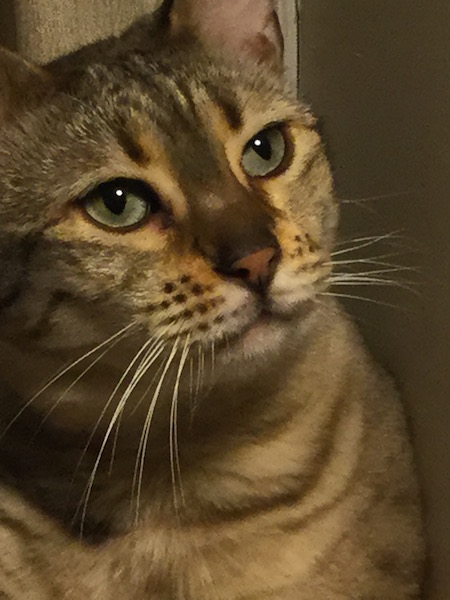
Billie the Bengal, 11-20-15. Photo by A. D. Coleman.
•
Special offer: If you want me to either continue pursuing a particular subject or give you a break and (for one post) write on a topic — my choice — other than the current main story, make a donation of $50 via the PayPal widget below, indicating your preference in a note accompanying your donation. I’ll credit you as that new post’s sponsor, and link to a website of your choosing.
And, as a bonus, I’ll send you a signed copy of my new book, poetic license / poetic justice — published under my full name, Allan Douglass Coleman, which I use for my creative writing.






Sorry for your loss Allan, a beautiful heartfelt tribute to Billie.
Extraordinary are cats and their loss is profound, thank you for sharing.
We lost our rescue cat Daisy in 2020, not knowing her birthday we commissioned a flower pot to be planted with daisies inscribed:
Daisy 05:06:20
Forever loved
Forever missed
Forever in the sun
We found, as you obviously did, it was a privilege to be allowed to share her life.
A beautiful tribute to a wonderful cat. I was never sure who I wanted to spend time with when we visited you, you and Anna, or Billie. XXXOOO Billie
Thanks for sharing your story. Cats are, indeed, some special creatures and your Billie, wherever she may be, will always remember you, as you remember her. Losing one’s cat, should I say friend, is always a pain. Here is my story with Little One:
https://medium.com/cat-respect/the-day-i-put-little-one-to-rest-f5deac12effc
Fortunately, Yellow is still making me company, although I know I will suffer again whenever she goes away.
Beautiful, Allan. Sorry to hear of her passing. Thanks so much for offering this.
Billie is in cat heaven; warm, content and loved forever. RIP
All the Above = Mea Mow Billy R.I.P
Allan, I do remember your posts where Billie made an appearance. Otis, my cat waved hello to Billie in one of my replies. Otis is no longer able to respond but Leo the new kitten sends his condolences I’m sure.
A lovely story Allan.
My sympathies to you and Anna.
Happy Memories.
Dear Allan –
I just wanted to reach out and say how deeply I was moved by your memorial tribute to Billie. It was beautifully written – simple and heartfelt.
With love and best wishes to you and Anna –
Barbara